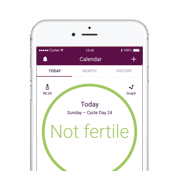Fertility unawareness
Do YOU know when in their cycle a person is most likely to get pregnant? If so, please tell a friend.

The good news? Young folks who have used fertility awareness or withdrawal (a.k.a. pulling out) for birth control have a better idea of when in a person’s cycle they’re most fertile compared to folks who have never used those methods. The bad news? That’s not sayin’ much.
A Research Brief from Child Trends used data from the National Survey of Reproductive and Contraceptive Knowledge to look at the fertility knowledge of 1,800 unmarried 18-29-year-old people in the U.S. The survey asked participants “During a woman’s monthly cycle, are there certain days when she is more likely to become pregnant if she has sex?” If participants answered “yes"—and 87% did—they were then asked "For most women, is this time: a) just before her period begins; b) during her period; c) right after her period has ended; or d) halfway between two periods?”
The correct answer for most* women is d), halfway between two periods. Unfortunately, only one-third of the folks surveyed knew that. Yep—that means two-thirds didn’t.
Ladies were slightly less clueless than guys. 42% of women knew when a woman is most fertile, compared to 27% of men. Ladies’ knowledge improved as they got older, but guys’ knowledge remained low.
Sex ed didn’t make a difference. The researchers didn’t see any connection between fertility knowledge and having received formal sex education—or sexual health care from a clinic or doctor’s office, for that matter.
Ladies who had used fertility awareness were less clueless than those who hadn’t. 58% of women who’ve used natural family planning (what we call fertility awareness) knew when in her cycle a woman is most fertile, compared to 41% of women who haven’t. That’s still 42% of women who’ve relied on inaccurate fertility knowledge to avoid getting pregnant. (Yikes.)
Guys who had used withdrawal were less clueless than those who hadn’t. 29% of men who’ve used withdrawal knew when in a woman’s cycle she’s most fertile, compared to 23% of those who haven’t. That leaves a whopping 71% of withdrawal users who didn’t know when in a woman’s cycle she’s most likely to get pregnant.
Knowing the basics about fertility is useful for anyone who has had, is having, or will someday have sex—not just for folks who use fertility awareness (or withdrawal) for birth control. Granted, if you’re already on a hormonal method you can’t actually track fertility since the hormones inhibit the natural cycle, but it’s still a good idea to understand how it all works.
The how-to section of our fertility awareness method details page has short explanations of the different ways women can track their fertility and our Provider Perspective on skipping periods has a good rundown of how hormonal birth control affects your cycle. Learn something new, then tell a friend!
*Note: We say “most women” because it might not be the case for women with irregular periods. The “halfway” estimate also fails to take into account the fact that sperm can survive for up to 5 days in a woman’s reproductive tract.
How do you feel about this article?

Heat up your weekends with our best sex tips and so much more.

